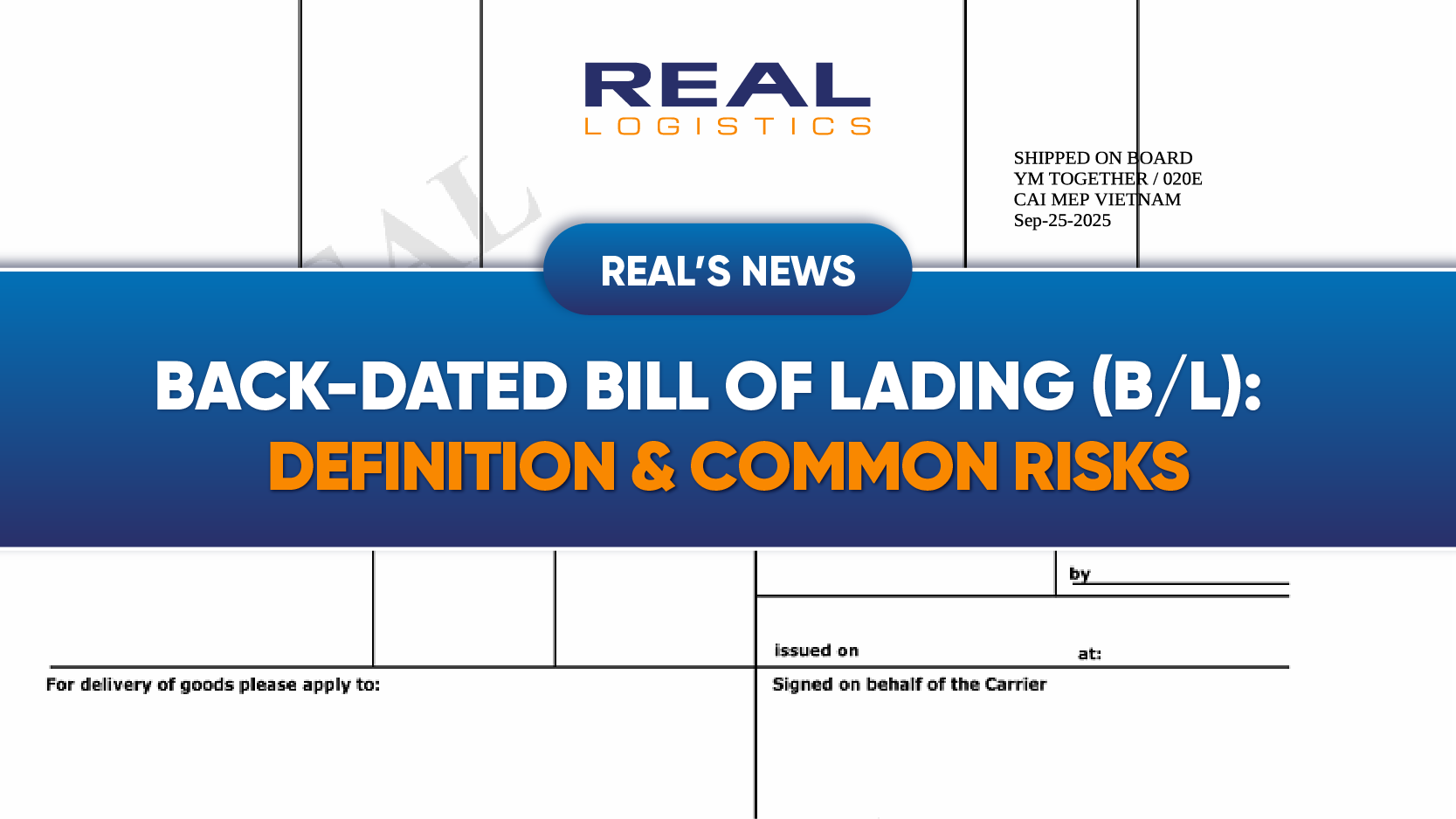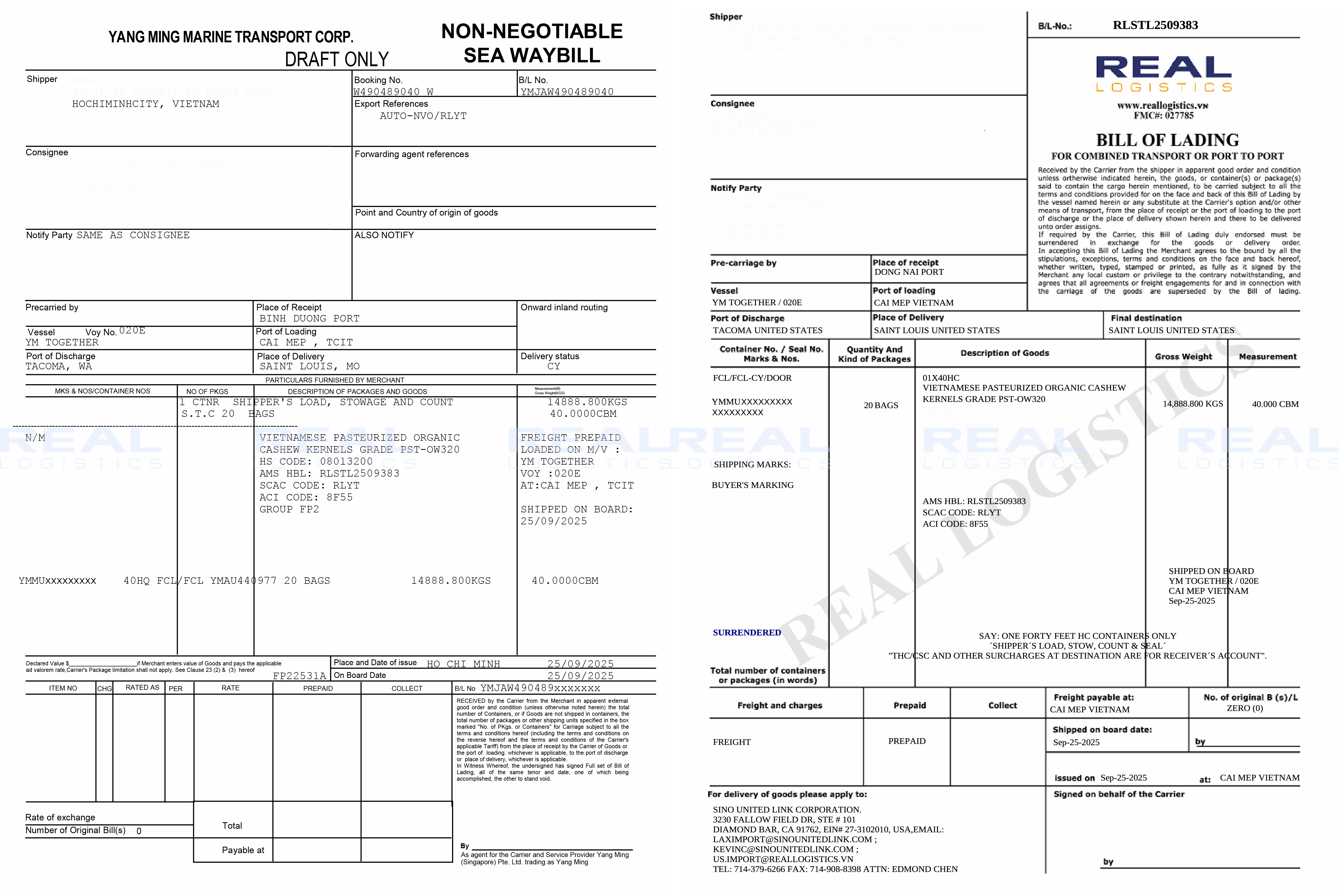Back-Dated Bill of Lading (B/L): Definition, Applicable Cases, and Common Risks

1. What Is a Back-Dated Bill of Lading?
A back-dated bill of lading (Backdated B/L) refers to a B/L that shows an issue date or on-board date earlier than the actual loading date of the cargo.
In international shipping practice, backdating a B/L is generally discouraged, as it misrepresents the actual shipment date. However, in real logistics operations, this can occur when shippers request it to meet the documentary requirements of an L/C, export license, or shipment deadline.
Since a B/L functions as both a transport document and a financial instrument in trade finance, any discrepancy in its date (e.g., actual loading vs. stated date) can lead to serious consequences - payment rejection by banks, buyer claims, or exclusion from marine insurance (P&I) coverage.
For forwarders and carriers, handling such requests from shippers is often a delicate matter that requires balancing customer relations with legal compliance and insurance liability.

2. Why Do Back-Dated B/L Requests Occur?
Requests for back-dated bills of lading typically fall into three main categories:
2.1. To Align with L/C or Documentation Requirements
This is the most common scenario. It happens when the actual loading date is later than the latest shipment date specified in the L/C or the expiry date in an export license.
If the B/L reflects the actual date, the bank may reject the document set due to non-compliance.
In these cases, the shipper may request a back-dated B/L and provide:
- A copy of the sales contract, L/C, and export license;
- A Letter of Indemnity (LOI) assuming full responsibility in case of dispute.
Some practitioners informally suggest that the backdating should not exceed three (03) days and must be supported by clear evidence. However, this is not an official rule under any international convention or maritime law.

2.2. To Circumvent Regulations or Gain Tax/Customs Benefits
In some cases, backdating may be intended to match a date that qualifies the shipment for certain tax exemptions or export incentive programs.
However, customs and tax authorities in the destination country typically verify shipments through arrival records at the port of discharge, so backdating the B/L rarely secures any actual benefit.
If discrepancies are found, the shipment documentation could be flagged for non-compliance or even fraudulent declaration.
2.3. For Financial Gain or Commercial Fraud
The most severe cases involve requests to issue a bill of lading before the goods are actually loaded, or when the forwarder has not yet received the cargo.
Here, the shipper might use the falsified B/L to present documents to the bank and receive payment before goods are shipped - and potentially disappear without delivering.
This practice constitutes a serious commercial fraud and can lead to criminal liability and major financial loss for all parties involved.
3. Required Documents When Requesting a Back-Dated B/L
According to industry practice, companies seeking a back-dated bill of lading (for documentation alignment) may need to provide:
- Copies of the sales contract, L/C, and export license, or related paperwork;
- A Letter of Indemnity (LOI) - confirming full responsibility for any disputes resulting from the backdated issue.
However, an LOI is merely a civil indemnity, not an absolute legal protection in case of international claims or litigation.
4. Potential Risks
Although the reasons for backdating vary, most professional sources emphasize that this practice entails multiple operational, legal, and reputational risks, including:
5. Responsibility and Legal Principles in Issuing Bills of Lading
Under Article 249 of the Vietnam Maritime Code (2015), a bill of lading shall only be issued once cargo has been loaded on board.
This principle ensures that:
- The goods are under the carrier’s custody at the time of issuance;
- False or pre-issued B/Ls (before on-board) are prevented.
If a shipper requests backdating, the carrier or agent will usually require legitimate documentation and a written indemnity. Conversely, if a carrier or agent unilaterally alters the date, they may bear direct liability under maritime law and international conventions.
6. Key Warning Signs for Businesses
Real Logistics highlights several warning indicators that companies should carefully consider before agreeing to a back-dated B/L:
- Requests to issue a bill before the vessel’s departure or prior to cargo loading;
- A B/L date significantly earlier than the actual on-board date;
- Shippers reluctant to provide supporting documentation (sales contract, L/C, export license);
- Links to tax benefits, discounts, or promotional timelines requiring specific dates.
7. Conclusion
Backdating a bill of lading is a sensitive issue in international shipping and trade finance. It is not recommended, and in many cases, is explicitly excluded from P&I insurance coverage, meaning that the forwarder, carrier, and shipper all bear the resulting risks.
While some may consider it a temporary measure to align documentation, without clear justification and valid proof, it can trigger serious legal and financial consequences. Instead of resorting to backdating, businesses should proactively manage shipment schedules, monitor documentation deadlines, and coordinate early with banks or trading partners for compliant alternatives.
With over 16 years of experience in international freight forwarding, Real Logistics prioritizes compliance, transparency, and customer protection. We ensure documentary accuracy to minimize risks and strengthen our clients’ reputation in global trade.

Frequently Asked Questions (FAQ)
1. Is backdating by 1-3 days considered “safe”?
Some practitioners mention a 1-3 day range in certain cases for document alignment. However, this is not a universal standard, and acceptance varies depending on each party’s internal policy and applicable regulations.
2. When might backdating be “considered”?
It is occasionally mentioned in cases where the actual loading is slightly later than the L/C or export license date. The decision ultimately depends on the supporting documents and agreement between the involved parties.
3. Is an LOI (Letter of Indemnity) mandatory?
Some carriers or forwarders require an LOI when considering a back-dated issue. Its validity and enforceability depend on the specific wording and legal context.
4. What if the goal is to obtain tax incentives or export benefits?
This scenario demands extra caution, as each country has its own customs control system at the destination. Documentation discrepancies could lead to compliance audits.
5. How does fraudulent use of a back-dated B/L occur?
For example, a shipper requests a pre-dated B/L to present to the bank, receives payment, and never ships the cargo. This is a high-risk fraud scenario that all parties are strongly advised to avoid.
—————————————
Real Logistics Co.,Ltd
👉 Facebook: Real Logistics Co.,Ltd
☎️ Hotline: 028.3636.3888 | 0936.386.352
📩 Email: info@reallogistics.vn | han@reallogistics.vn
🏡 Address: 39 - 41, B4 Street, An Khanh Ward, Ho Chi Minh
G2 Floor, No. 51, Quan Nhan Street, Thanh Xuan Ward, Hanoi

